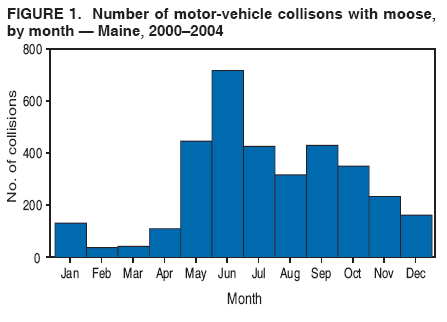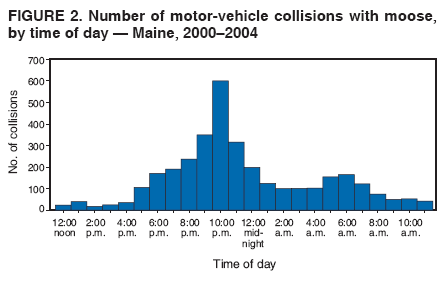 |
|
|
|
|
|
|
| ||||||||||
|
|
|
|
|
|
|
||||
| ||||||||||
|
|
|
|
|
Persons using assistive technology might not be able to fully access information in this file. For assistance, please send e-mail to: mmwrq@cdc.gov. Type 508 Accommodation and the title of the report in the subject line of e-mail. Injuries from Motor-Vehicle Collisions with Moose --- Maine, 2000--2004Moose are among the largest mammals in North America. Standing up to 7.5 feet at the shoulder and weighing up to 1,600 lbs, they are the largest members of the deer family (1--3). Maine's moose population (approximately 29,000) is the biggest in the United States outside of Alaska (4). During a collision with a motor vehicle, a moose usually is struck in the legs, causing its body to roll onto the hood of the vehicle, often collapsing the windshield and roof. As a result, motor-vehicle collisions involving moose are capable of causing substantial injury to vehicle occupants (3). To assess motor-vehicle collisions with moose in Maine and evaluate risk factors for injuries from these types of collisions, the Maine Department of Health and Human Services studied collision reports from 2000--2004. The results of that study indicated that collision rates varied by county but had clear patterns by season and time of day. Variables associated with risk for injury were posted speed limit, type of vehicle, and sex and age of the driver. Measures to reduce collisions with moose should focus on improving driver education programs and developing better engineering controls (e.g., removing roadside vegetation to improve visibility for drivers). In addition, herd management (i.e., decreasing moose population size through hunting) is currently being used in areas of Maine with high numbers of collisions, although studies are needed to assess its effectiveness. Information was obtained from motor-vehicle collision reports submitted to the Maine Department of Transportation (DOT) by state, county, and local police during 2000--2004 using a standard form. DOT then entered the report information into two separate data sets: one containing collision information and the other containing driver information. DOT classified collisions into three categories: 1) collisions causing fatal injuries, 2) collisions causing nonfatal injuries, and 3) collisions causing no injuries (5). A nonfatal injury was subcategorized as an incapacitating injury, a nonincapacitating injury, or a possible injury. A noninjury collision was one that resulted in property damage only. Collision rates were calculated using population figures from the 2000 U.S. census. Relative risks (RRs) were calculated for selected exposure variables. Significant (p<0.05) variables were then assessed by logistic regression analysis. During the 5-year period, 22,516 motor-vehicle collisions with animals were reported in Maine. Of these collisions, 18,289 (81%) were with deer, 3,400 (15%) with moose, and 827 (4%) with other animals. A total of 1,600 injuries (1,583 nonfatal and 17 fatal) were caused by these collisions. Although collisions with moose accounted for only 15% of collisions with animals, they accounted for 803 (50%) of the 1,600 total injuries: 14 (82%) of the 17 fatal injuries and 789 (50%) of the 1,583 nonfatal injuries. The yearly collision rate with moose was 53 per 100,000 persons overall and ranged from seven to 310 in Maine's 16 counties. Rates were highest in the less populous northern part of the state and lowest in the more populous southeastern part of the state. The majority (2,683 [79%]) of collisions with moose occurred during May--October, with the greatest number of crashes (716 [21%]) occurring in June (Figure 1). The peak time of day for collisions was 10--11 p.m., with 600 collisions (18%); a total of 2,645 (78%) collisions occurred during 6 p.m.--6 a.m. (Figure 2). Occupants of vehicles involved in motor-vehicle collisions with moose were more likely to be injured from the collision when the posted speed limit was >40 m.p.h. (RR = 1.9, 95% confidence interval [CI] = 1.1--3.3). Neither daylight nor wet road conditions caused by precipitation were significantly associated with a higher risk of being injured in a moose collision. Data regarding locations of collisions were limited to the county level, so particularly high-risk roads or locations could not be identified. Of the 3,400 collisions with moose, 33 were multivehicle collisions; a total of 3,442 drivers were involved. Because the data assessment did not include identity of the drivers, whether a particular driver had been involved in more than one collision could not be determined. The median age of drivers was 43 years (range: 15--90 years). Seventy-three percent of drivers were male, and 99% were considered in normal physical condition at the time the collision occurred; 1% were classified as fatigued, ill, handicapped, or under the influence of alcohol or drugs. Among drivers involved in collisions with moose, drivers of cars had a higher (38%) chance of being injured than drivers of certain other vehicles (10%) (e.g., sport-utility vehicles [SUVs], trucks, vans, buses, farm vehicles, and commercial vehicles) (RR = 3.4, CI = 2.9--3.9).* Drivers aged <25 years were more likely to be injured than drivers aged >25 years (RR = 1.5, CI = 1.3--1.8), and women were more likely to be injured than men (RR = 1.6, CI = 1.4--1.8). In logistic regression analysis, only driver age and vehicle type were associated with risk for driver injury. Drivers aged <25 years had higher odds of injury than older drivers (odds ratio [OR] = 1.3, CI = 1.0--1.6). Male drivers of cars had higher odds of injuries (OR = 4.7, CI = 3.7--5.9) than female drivers of cars (OR = 2.8, CI = 1.9--3.9). Reported by: A Pelletier, MD, Div of State and Local Readiness, Coordinating Office for Terrorism Preparedness and Emergency Response, CDC. A Rey, MPH, EIS Officer, CDC. Editorial Note:Collisions between moose and motor vehicles in Maine cause a disproportionately high number of injuries compared with collisions with other animals. Differences in rates among counties likely are a result of variations in the moose and human population sizes in different areas of the state. The moose population is greater in the northern region of Maine, which has fewer persons than the southern region. The distinct seasonal pattern of collisions with moose (i.e., higher numbers in May--October) correlates with the increased activity of moose during the warmer months and the September--October mating season; in contrast, the deer mating season occurs during October--December, which correlates with higher numbers of deer collisions during these months. The daily time pattern, with higher numbers of collisions occurring during 6 p.m.--6 a.m., seems to correspond with daily patterns of moose activity; moose are more active in the evening and at dawn. In addition, few roads in Maine are lighted, so seeing moose on roads at night is difficult. The finding that vehicle type was associated with injury in the logistic regression model supports other studies that have found that vehicle type influences likelihood of injury (2). The additional height and mass of larger vehicles such as trucks and SUVs might help protect drivers of these types of vehicles from injury. The association between younger driver age and higher risk for injury might be a result of younger drivers' inexperience and driving habits such as speeding or not using safety belts (6,7). Differences in injury by sex might have been the result of factors that were not included in the logistic regression model (e.g., speed limit, safety-belt use, or driver behavior). The findings in this report are subject to at least three limitations. First, information on safety-belt use was not included in either data set provided by DOT, although it is recorded in the vehicle collision reports that are submitted to DOT by police. Although the association of safety-belt use with risk for injury could not be assessed in this study, the use of safety belts is the most effective means of reducing fatal and nonfatal injuries in motor-vehicle crashes (8). Second, information regarding the distribution of moose throughout the state was limited. As a result, collision rates based on moose population density could not be calculated. Finally, although the posted speed limit was associated with injury in the bivariate analysis, it was not included in the logistic regression model because of difficulties associated with merging the collision and driver data sets. Several public awareness initiatives to prevent motor-vehicle collisions with moose in Maine are ongoing. For example, a statewide campaign involves alerting the public about moose collisions and providing tips for drivers on ways to avoid or decrease the severity of collisions with moose. Brochures are available at libraries, schools, state parks, tourism centers, and other distribution points throughout Maine. In addition, a module on large-animal collisions is a component of Maine Department of Motor Vehicles driver education programs. Other strategies include engineering controls such as clearing roadside vegetation to improve sight lines and placing signs on roads known to have frequent vehicle-moose collisions. Herd management might be an effective strategy in areas with large moose populations. Maine currently manages the size of the moose population through hunting by increasing the number of available moose-hunting permits in areas with high numbers of collisions. Studies are needed to assess the effectiveness of this and other strategies currently being used to reduce the numbers of motor-vehicle collisions with moose. Acknowledgments This report is based, in part, on data provided by G Costello, Maine Dept of Transportation, and contributions from A Yartel, MPH, Maine Dept of Health and Human Svcs, J Magri, MD, and A De, PhD, Office of Workforce and Career Development, CDC. References
* Because few collisions occurred with motorcycles, they were excluded from the analyses but are included in the total numbers of collisions presented in this report. Figure 1  Return to top. Figure 2  Return to top.
Disclaimer All MMWR HTML versions of articles are electronic conversions from ASCII text into HTML. This conversion may have resulted in character translation or format errors in the HTML version. Users should not rely on this HTML document, but are referred to the electronic PDF version and/or the original MMWR paper copy for the official text, figures, and tables. An original paper copy of this issue can be obtained from the Superintendent of Documents, U.S. Government Printing Office (GPO), Washington, DC 20402-9371; telephone: (202) 512-1800. Contact GPO for current prices. **Questions or messages regarding errors in formatting should be addressed to mmwrq@cdc.gov.Date last reviewed: 11/29/2006 |
|||||||||
|